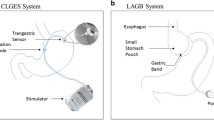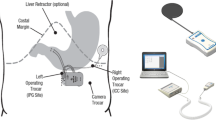En
Abstract
Background
The prevalence of obesity is growing worldwide. Medical therapies are often ineffective, and surgical treatments have significant risk. IGS® offers a novel approach to weight loss that was found to be safe and effective in European trials. In the U.S., 2 consecutive trials have been undertaken.
Methods
In 2000, a multicenter, prospective, randomized, placebo-controlled trial involving 103 morbidly obese patients (U.S. O-01) was undertaken. In 2002, a prospective, open label trial involving 30 morbidly obese patients was initiated (DIGEST). Patients were followed for complications, postoperative untoward events, and weight loss.
Results
In O-01, there were no significant perioperative complications. However, 20 patients were found to have had lead dislodgements. At 7 months, there was no significant difference in weight loss between the activated and non-activated groups. After 29 months, loss of excess weight (EWL) approached 20%. With DIGEST, there was 1 operative complication (a lost needle retrieved surgically). There were no untoward events or known lead dislodgements. EWL was 23% after only 16 months follow-up. With the introduction of a preoperative screening algorithm, almost 40% EWL was achieved for selected patients in both trials.
Conclusions
In the U.S., the IGS system for the treatment of obesity has been shown to be safe. Technical improvements and better patient selection resulted in improved weight loss. The preliminary results of these trials suggest that IGS may be a suitable surgical option for selected patients.
Similar content being viewed by others
References
Flegal KM, Carroll MD, Ogden CL et al. Prevalence and trends in obesity among US adults, 1999–2000. JAMA 2002; 288: 1723–7.
Freedman DS, Khan LK, Serdula MK et al. Trends and correlates of class 3 obesity in the United States from 1990–2000. JAMA 2002; 288: 1758–61.
Steinbrook R: at]Fr Surgery for severe obesity. N Engl J Med 2004; 350: 1075–9.
Schauer P, Ikramuddin S, Gourash W et al. Outcomes after laparoscopic Roux-en-Y gastric bypass for morbid obesity. Ann Surg 2000; 232: 515–29.
Pories WJ, Swanson MS, MacDonald KG et al. Who would have thought it? An operation proves to be the most effective therapy for adult-onset diabetes mellitus. Ann Surg 1995; 222: 339–52.
Dixon JB, O’Brien P. Health outcomes of severely obese type 2 diabetic subjects 1 year after laparoscopic adjustable silicone gastric banding. Diab Care 2002; 25: 358–63.
Must A, Spadano J, Coakley EH et al. The disease burden associated with overweight and obesity. JAMA 1999; 282: 1523–9.
Shikora SA. Implantable gastric stimulation for the treatment of severe obesity. Obes Surg 2004; 14: 545–8.
D’Argent J. Implantable gastric stimulation as therapy for morbid obesity: Preliminary results from the French study. Obes Surg 2002; 12: 21S–24S.
Favretti F, De Luca M, Segato G et al. Treatment of morbid obesity with the Transcend® Implantable Gastric Stimulator (IGS®): A prospective survey. Obes Surg 2004; 14; 660–70.
Cigaina V. Gastric pacing as therapy for morbid obesity. Preliminary results. Obes Surg 2002; 12: 12S-16S.
Bjorntrop P. Treatment of obesity. Int J Obes 16 1992; 3 (Suppl 16): S81–S84.
Scopinaro N, Adami GF, Marinari GM et al. Biliopancreatic diversion. World J Surg 1998; 22: 936–46.
Rubenstein RB. Laparoscopic adjustable gastric banding at a U.S. center with up to 3-year follow-up. Obes Surg 2002; 12: 380–4.
Hsu LKG, Benotti PN, Dwyer J et al. Nonsurgical factors that influence outcome of bariatric surgery: A review. Psychosomatic Med 1998; 60: 338–346.
Green A E-C, Dymek-Valentine M, Pytiuk S et al. Psychosocial outcome of gastric bypass surgery for patients with and without binge eating. Obes Surg 2004, 14: 975–85.
Poole N, Al Atar A, Bidlake L et al. Pouch dilatation following laparoscopic adjustable gastric banding: psychobehavioral factors (Can psychiatrists predict pouch dilatation?) Obes Surg 2004; 14: 798–801.
Chen JD, Qian L, Ouyang H. Gastric electrical stimulation with short pulses reduces vomiting but not dysrhythmias in dogs. Gastroenterology 2003; 124: 401–9.
Xing JH, Brody F, Brodsky J et al. Gastric electrical stimulation at proximal stomach induces gastric relaxation in dogs. Neurogastroenterol Motil 2003; 15: 15–23.
Cummings DE, Weigle DS, Frayo RS et al. Plasma ghrelin levels after diet-induced weight loss or gastric bypass surgery. N Engl J Med 2002; 346: 1623–30.
Cigaina V, Hirschberg AL. Gastric pacing for morbid obesity: plasma levels of gastrointestinal peptides and leptin. Obes Res 2003; 11: 1456–62.
Author information
Authors and Affiliations
Corresponding author
Rights and permissions
About this article
Cite this article
Shikora, S.A. “What are the Yanks Doing?” The U.S. Experience with Implantable Gastric Stimulation (IGS) for the Treatment of Obesity — Update on the Ongoing Clinical Trials. OBES SURG 14 (Suppl 1), S40–S48 (2004). https://doi.org/10.1007/BF03342137
Published:
Issue Date:
DOI: https://doi.org/10.1007/BF03342137




